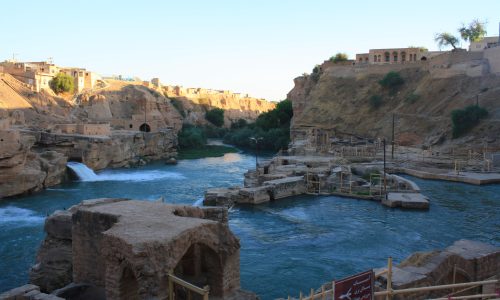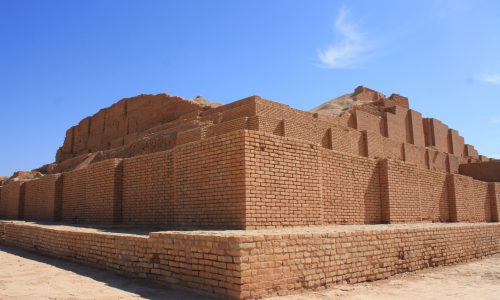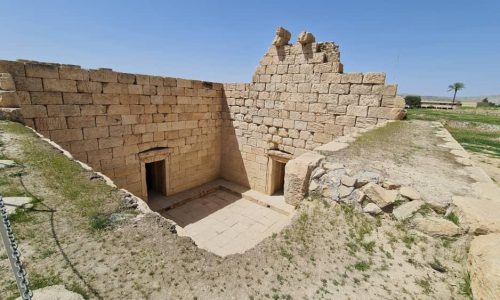Ahwaz Tours
Ahwaz Tours

At 08:00 in the morning, your guide will pick you up from your hotel in Ahvaz and drive to Shushtar (85 km). Shushtar, as the origin of civilization in Iran, is an inseparable part of Ahwaz tours. We will visit Shushtar water mills. The construction of the Shushtar watermills began during the Achaemenid period and ended in the Sassanid era. These waterfalls are also known as the Shushtar Historical Hydraulic System. In this large complex, there are mills, waterfalls, canals, massive water tunnels, and waterfalls for the relaxation of visitors. UNESCO has inscribed Shushtar waterfalls on its World Heritage Sites list. Then, we will visit the traditional bazaar of Shushtar which has not only beautiful local architecture but also good souvenirs for visitors to buy. There are several houses in Shushtar which worth visiting as well, like Saray-e Afzal (Afzal House), Tabib-e Shushtar Historical House, Aminzadeh House, and Mostofi House. After that, we will visit Salasal Castle and the bridge of Valerian which was built by the Sassanids, using Roman prisoners of war as workforce, in the 3rd century AD. It was also the most eastern example of a Roman bridge design and dam, lying deep in Persian territory. We will back to Ahwaz at 16:00.

Excursion to Susa
Morning at 08:00, your guide will pick you up from your hotel in Ahwaz and drive to Susa (191 km) to visit Chogha Zanbil Ziggurat (UNESCO World Heritage). Tchogha Zanbil is a must-see on Ahwaz tours. It comprises the ruins of the holy city of the Kingdom of Elam, centered on a great ziggurat and surrounded by three huge concentric walls. Founded around 1250 BC, the city remained unfinished after it was invaded by Ashurbanipal in 640 BC. Its ziggurat is considered to be the best-preserved example in the world. It is one of the few extant ziggurats outside of Mesopotamia. The complex is protected by three concentric walls, which form three main areas of the “town.” The inner area is wholly taken up with the great ziggurat dedicated to the main god. The middle area holds eleven temples for lesser gods. In the outer area are royal palaces, a funerary palace containing five subterranean royal tombs, and a necropolis containing non-elite tombs. Then, we will visit the ruins of Haft Tappeh which is another Elamite archaeological site composed of many individual mounds, forming an imposing mass rising about the surrounding plain. The number seven, haft in Haft Tepe, meaning the “Seven Mounds”, is used loosely to indicate the number of mounds in this large archaeological complex. After lunch, we will visit The Apadana of the Palace of Darius in Susa, The Apadana (audience hall) of the Palace of Darius in Susa (Iran) was a large hypostyle room of 36 columns. Measuring 109 meters (357 feet) on each side, it was very similar to that of Persepolis in plan and dimensions with distinctive Persian columns, topped by two bulls. Then, we will visit the Susa Museum and Acropol Castle. After that, we will visit Danial’s tomb. The Tomb of Prophet Daniel is the traditional burial place of the biblical prophet. Various locations have been named for the site, but the tomb in Susa, Iran (Persia), is the most widely accepted. We will back to the hotel in Ahwaz at 17:00.

Ahwaz City Tour and Street Food
Ahvaz is one of the unique tourist cities in Khuzestan, which has a variety of Arab, Lur, and Bakhtiari tribes who live side by side. Ahvaz is divided into two parts by the Karun River. There are several bridges worth seeing: the white bridge, the black bridge, and the Ajam historical bridge. In general, the western part of the city includes more populated areas such as Kianabad, Golestan, and Kianpars. Besides, Clock Square is one of the famous squares of Ahvaz considered the central core of the western part. The eastern part of Ahvaz city mostly includes shopping malls and different markets. One of the most traditional markets in the eastern part of Ahvaz is a market called Abdolhamid Bazaar. Christian Catholic Church is one of the sites we will visit today. Then, we will pay a visit to the Museum of Contemporary Art which is one of the tourist attractions in Ahvaz. It operates on 2 floors with different galleries. Ahwaz has a variety of weather conditions, but its best season is winter and spring, which is usually not dusty and you can enjoy its beautiful nature. The existence of different cultures and ethnicities in this city has caused a high variety of local and traditional cuisines in Ahvaz. Lashkarabad is one of the famous districts of Ahvaz, located in an Arab neighborhood. In this neighborhood, you will see various food shops such as falafel, samosa, and fried mushrooms. Most of these shops are self-service. Ahwaz tours also allow you to test tasty colorful foods! You can find the most delicious falafels in Khuzestan. Moreover, most of the city’s cuisine is spicy and has a unique color and smell. Other popular cuisines in the city include shrimp, pakura, ranginak, nafeleh, saboor fish, hamis cub, and alkaline fish. So, we will get familiar with some of the famous foods and their ingredients.

Ahwaz to Shiraz Tour with Stop at Bishapour
Morning at 08:00, we will drive to Shiraz (539km). On the way, we will visit Bishapur (UNESCO Heritage) which was an ancient city in Sasanid Persia (Iran), on the ancient road between Persis and Elam. The road linked the Sassanid capitals Estakhr (very close to Persepolis) and Ctesiphon. Then, we will visit Anahita Temple which is one of the most famous buildings in the ancient city of Bishapur. This cubic structure, about 14 m in height, was built with clean-cut stones attached with metal staples inspired by Achaemenid architecture in the Sassanid period. The roof was open due to the easy flow of water into the Shapur River so that the stored water could be drained off the aqueduct near the temple. Furthermore, the temple had no ceiling and was built 6 meters lower than the surface to direct the flow of the Shapur River into it. It is a building without parallel. Once you have descended the stairway, you will find yourself in a small square, surrounded by high walls. The square itself must have been a shallow pool, surrounded by sidewalks. The doors in the walls gave access to a corridor that surrounded the square, which in turn gave access to the place where the aqueduct reached this square building. Just beside the ancient city of Bishapur, there are six bas reliefs of the Sassanid Era in Tang-e Chogan Valley. Some inscriptions of Sassanid kings on the four corners around a river in this valley are invaluable heritages. In the Chogan Valley, on the precipice of the mountain and both sides of a river, many carvings can be distinguished: two men on their horses standing face to face and a third person bending on his knees stretching his hands as though begging for forgiveness. It seems to be an impression of Shapour on a horse, with curly hair and a crown of a monarch. Above Shapour’s head, there is an angel with a horn. On two sides of the carvings, are two arches, in each of which three people carved. It seems that Shapour is receiving people with gifts for him. This shows Shapour with two armed soldiers on their horses, one of them is giving a ring to the other. Finally, we will drive to Shiraz and check in at the hotel.
